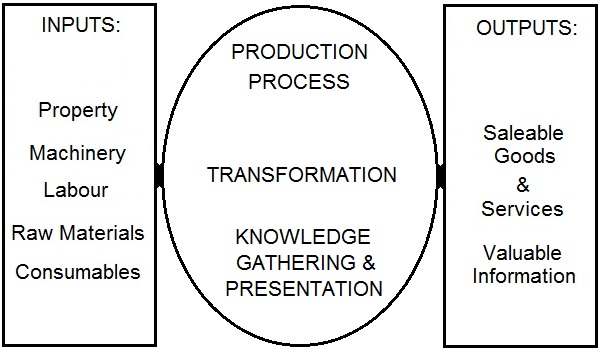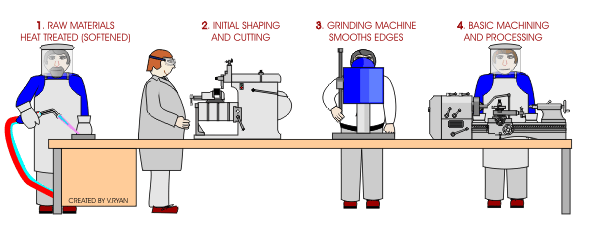Hi Everyone,
Last week, we were given a picture and asked to come up with
questions and about the picture. One of the questions was how do products get
from manufacturers to consumers, which got me thinking about the production
process. So today, I’d like to talk about the process by which we get our goods
and services from producers. As you are all aware, we have learnt so far in
Economics class about the production cycle. We learnt that through the
production cycle, people provide producers with factors of production (e.g.
labour), and consumer expenditure, and they in turn provide goods and services,
and wages, rent and dividends to consumers or households.
The Times 100 Business
Case Studies describes the production process as the economic process which
involves transferring a range of inputs into those outputs that are required by
the market. There are 2 types of resources involved in the production process:
the transforming resources and the transformed resources. The transforming
resources include the buildings, machinery, computers (land and capital) and
people (labour) that carry out the transforming processes. The transformed
resources are the raw materials and components that are transformed into end
products.
Any production process involves a series of stages in a
production chain. At each stage, value is added in the course of production.
Adding value involves making a product more desirable to a consumer so that
they will pay more for it. Adding value therefore is not just about
manufacturing, but includes the marketing process, including advertising,
promotion and distribution that make the final product more desirable. It is
very important for businesses to identify the processes that add value, so that
they can enhance these processes to the ongoing benefit of the business.
The article talks about three main types of production process:
job, batch and flow production.
Job production involves making an individual product or
service and finishing that project before moving on to another project. It is
the creation of single items by either one worker or a team of workers. Job
production is unique in the fact that the project is considered to be a single
operation, which requires the complete attention of the worker before he or she
passes on to the next job. Examples from the service industries include cutting
hair, and processing a customers' order in a store.
Some benefits of job production are:
1. The job is a unique product, which exactly matches the
requirements of the customer, often from as early as the design stage. It will
therefore tend to be tailored specifically to a customer's order.
2. Specifications for the job can change during the course
of production depending upon the customer's inspection to meet his or her
changing needs.
3. Working on a single unit job, coping with a variety of
tasks and being part of a small team working towards the same aim would provide
employees with a greater level of satisfaction. For example, aircrews working
for United Airways would treat each flight as a specific job, with passengers
requiring individual attention to their specific needs - e.g. for vegetarian
dishes, wheelchair access to the flight.
Batch production
The term batch refers to a specific group of components,
which go through a production process together. As one batch finishes, the next
one starts. For example on Monday, Machine A produces a type 1 engine part, on
Tuesday it produces a type 2 engine part, and so on, until all the engine parts
will finally be assembled together. This method is sometimes referred to as
'intermittent' production as different job types are held as work-in-progress
between the various stages of production.
The benefits of batch production are:
1. It is particularly suitable for a wide range of almost
similar goods, which can use the same machinery on different settings.
2. It makes possible economies of scale in techniques of
production, bulk purchasing and areas of organisation.
3. It makes costing easy and provides a better information
service for management.
Flow production
If the “rest” period in batch production disappeared it
would then become flow production. Flow production is therefore a continuous
process of parts and sub-assemblies passing on from one stage to another until
completion. For flow production to be successful there needs to be a continuity
of demand, otherwise, there would be a constant overstocking of finished goods.
The benefits of flow production include:
·
labour and other production costs will be
reduced through detailed planning and the use of robotics and automation
·
deviations in the line can be quickly spotted
through ongoing quality control techniques
·
as there is no rest between operations,
work-in-progress levels can be kept low
·
investment in raw materials and parts are
quickly converted into sales
·
control is easy.
This is a video showing flow production in the production of
carbonated soft drinks.
My Analysis
To conclude, I believe that the process by which products
and services are created is very important, as it is necessary to fuel the
economy. We also have to find ways to improve the production processes, in
order to ensure efficient use of resources at all times. Thank you.
Works Cited
http://businesscasestudies.co.uk/business-theory/operations/production-process.html#ixzz2iwAiBfJt




No comments:
Post a Comment
Note: Only a member of this blog may post a comment.